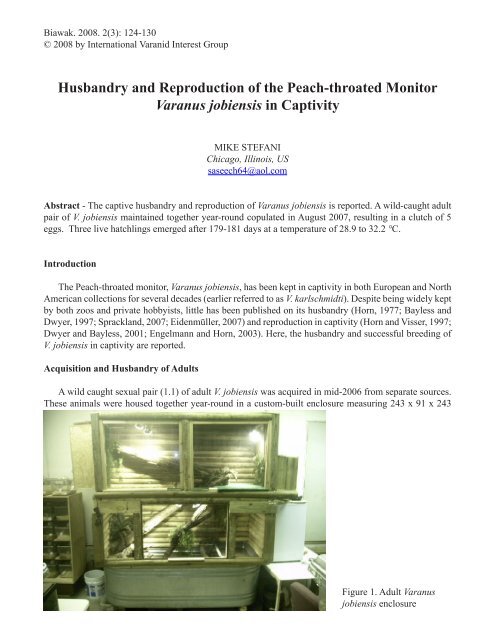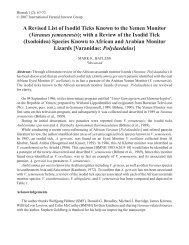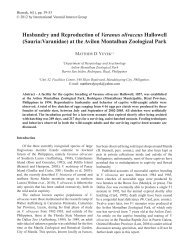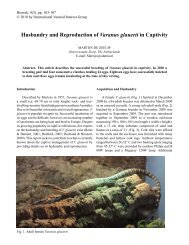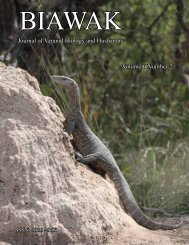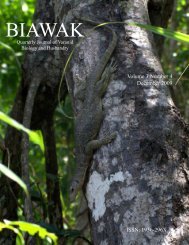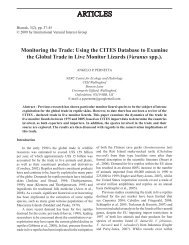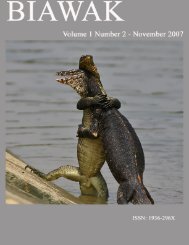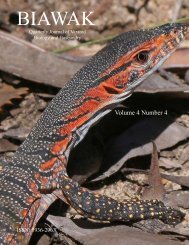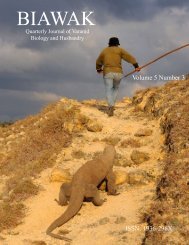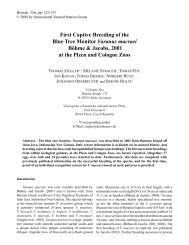Husbandry and Reproduction of the Peach-throated Monitor ...
Husbandry and Reproduction of the Peach-throated Monitor ...
Husbandry and Reproduction of the Peach-throated Monitor ...
You also want an ePaper? Increase the reach of your titles
YUMPU automatically turns print PDFs into web optimized ePapers that Google loves.
Biawak 2008 Vol. 2 No. 3126Courtship, Copulation <strong>and</strong> NestingCourtship behavior was first observed on 4 August 2007. The male would approach <strong>the</strong> female whilerapidly tongue-flicking on her head <strong>and</strong> rear legs, with his head twitching <strong>and</strong> swaying side to side as hewalked. The male would relentlessly pursue <strong>the</strong> female around <strong>the</strong> enclosure until she would submit tocopulation. Copulation occurred several times a day throughout <strong>the</strong> enclosure for 12 days, with each eventlasting between 10 min <strong>and</strong> 1 h in duration (Figure 3). No alternation <strong>of</strong> hemipenes was observed duringcopulation.Figure 3. Copulation <strong>of</strong> V. jobiensisFigures 4 & 5. Oviposition
127 Biawak 2008 Vol. 2 No. 3By 16 August, <strong>the</strong> male no longer showed interest in <strong>the</strong> female. Over <strong>the</strong> next several days <strong>the</strong>female began to increase in diameter <strong>and</strong> appeared noticeably gravid. During this time, <strong>the</strong> female wasseen seeking hotter basking temperatures than normal <strong>and</strong> resting in peculiar positions, such as liftingher abdomen up <strong>of</strong>f <strong>of</strong> basking spots or suspending her abdomen from objects in <strong>the</strong> enclosure ra<strong>the</strong>rthan resting directly on <strong>the</strong>m. These behavioral changes have remained consistent over four clutches laidby <strong>the</strong> female to date, <strong>and</strong> in addition to a sudden increase in girth, have become reliable indicators fordetermining whe<strong>the</strong>r or not <strong>the</strong> female is gravid.On 1 September 2007, two eggs which had been eaten <strong>and</strong> digested, as evidenced by <strong>the</strong>ir collapsedappearance, were found in <strong>the</strong> water basin. Test digging throughout <strong>the</strong> enclosure was observed two daysprior to oviposition. The female would dig several shallow pits <strong>the</strong>n insert her snout into <strong>the</strong> bottoms <strong>of</strong><strong>the</strong>se pits to presumably test <strong>the</strong> humidity <strong>and</strong> or temperatures.Oviposition occurred at night on 6 September 2007 (Figures 4 & 5). Despite <strong>the</strong> presence <strong>of</strong> anexternal nest box, <strong>the</strong> female deposited 3 eggs in <strong>the</strong> substrate <strong>of</strong> <strong>the</strong> enclosure at a depth <strong>of</strong> ca. 9 cm <strong>and</strong>at a temperature <strong>of</strong> ca. 30 °C. Clutch measurements are presented in Table 1. Following oviposition, <strong>the</strong>female traveled to <strong>the</strong> water basin to drink <strong>the</strong>n retreated to an external hide box towards <strong>the</strong> top <strong>of</strong> <strong>the</strong>enclosure.Incubation <strong>and</strong> HatchingThe eggs were retrieved <strong>and</strong> set up for incubation in a sealed 2.8 L plastic container. Glitter-gradevermiculite mixed with water by soaking <strong>and</strong> <strong>the</strong>n rung-out by h<strong>and</strong>, was used as incubation medium.The incubator, a modified mini-refrigerator with a 3 gallon water reservoir at <strong>the</strong> bottom, maintainedTable 1. Egg measurements* devoured/digested eggs not includedNo. Length (cm) Width (cm) Mass (g)1 5.7 2.5 24.42 6.0 2.5 24.83 6.4 2.5 24.5Table 2. Hatchling measurementsNo. SVL (cm) Total Length (cm)1 7.9 19.12 12.1 24.83 10.8 26.7
Biawak 2008 Vol. 2 No. 3128Figure 6. Hatching V. jobiensisFigure 7. Captive-bredV. jobiensis
129 Biawak 2008 Vol. 2 No. 3temperatures between 28.9 to 32.2 °C. The egg container was vented periodically for gas exchange.The first egg hatched on 3 March 2008 after 179 days <strong>of</strong> incubation. The remaining two eggs hatchedout on 4 <strong>and</strong> 5 March. Hatchling measurements are provided in Table 2. The hatchlings measured 7.9 cmsnout to vent length (SVL), 19.1 cm total length (TL); 12.1 cm SVL, 24.8 cm TL; 10.8 cm SVL, 26.7 cmTL, respectively.<strong>Husb<strong>and</strong>ry</strong> <strong>of</strong> OffspringFigure 8. Detail <strong>of</strong> ventralcoloration <strong>and</strong> patternAfter remaining in <strong>the</strong> incubator for two days, all three hatchlings were housed individually in 38 L (10gallon) aquaria. Sphagnum moss was provided as substrate <strong>and</strong> <strong>the</strong> rear walls were covered with tree bark.A basking branch <strong>and</strong> some tree bark scattered on <strong>the</strong> ground completed <strong>the</strong> furnishings <strong>of</strong> each setup.A pyrex bowl for water with a piece <strong>of</strong> silk foliage in <strong>the</strong> bowl was provided for each terrarium. Screenaquarium tops were completely covered with plastic sheeting to help retain humidity levels. Three 6 mmholes were made in <strong>the</strong> plastic sheeting to allow for adequate ventilation. Basking sites <strong>of</strong> 32.2 °C wereprovided by 50 watt inc<strong>and</strong>escent bulbs.The <strong>of</strong>fspring accepted food after 2 days. Roach nymphs (Blaptica dubia) <strong>and</strong> chopped pinkie micewere <strong>of</strong>fered daily. The raising <strong>of</strong> <strong>the</strong> <strong>of</strong>fspring has been without difficulties, <strong>and</strong> all three <strong>of</strong>fspring continueto grow rapidly.
Biawak 2008 Vol. 2 No. 3130Acknowledgements - I would like to thank everyone for <strong>the</strong>ir support, <strong>and</strong> I would especially like tothank <strong>the</strong> late Mark K. Bayless for his friendship <strong>and</strong> collaboration on varanids over <strong>the</strong> years.Literature CitedBayless, M.K. <strong>and</strong> Q. Dwyer. 1997. Notes on <strong>the</strong> <strong>Peach</strong>-Throated <strong>Monitor</strong>. Reptile <strong>and</strong> AmphibianMagazine 47: 26-30.Dwyer, Q. <strong>and</strong> M.K. Bayless. 2001. The peach-<strong>throated</strong> monitor: notes on husb<strong>and</strong>ry <strong>and</strong> reproductionbehavior. Reptile <strong>and</strong> Amphibian Hobbyist 7(1): 18-24.Eidenmüller, B. 2007. <strong>Monitor</strong> Lizards: Natural History, Captive Care <strong>and</strong> Breeding. Edition Chimaira,Frankfurt.Engelmann, W.-E. <strong>and</strong> H.-G. Horn. 2003. Erstmalige Nachzucht von Karl- Schmidt‘sWaran, Varanusjobiensis, im Zoo Leipzig. Der Zoologischer Garten 73: 353-358.Horn, H.-G. 1977. Notizen zur Systematik, Fundortangaben und Haltung von Varanus (Varanus)karlschmidti (Reptilia: Sauria: Varanidae). Salam<strong>and</strong>ra 13(2): 78-88.Horn, H.-G. <strong>and</strong> G. Visser. 1997. Review <strong>of</strong> reproduction <strong>of</strong> monitor lizards Varanus spp in captivity.International Zoo Yearbook 35(1): 227-246.Sprackl<strong>and</strong>, R.G. 2007. <strong>Peach</strong>-throat monitors. Reptiles 15(2): 40-47.


